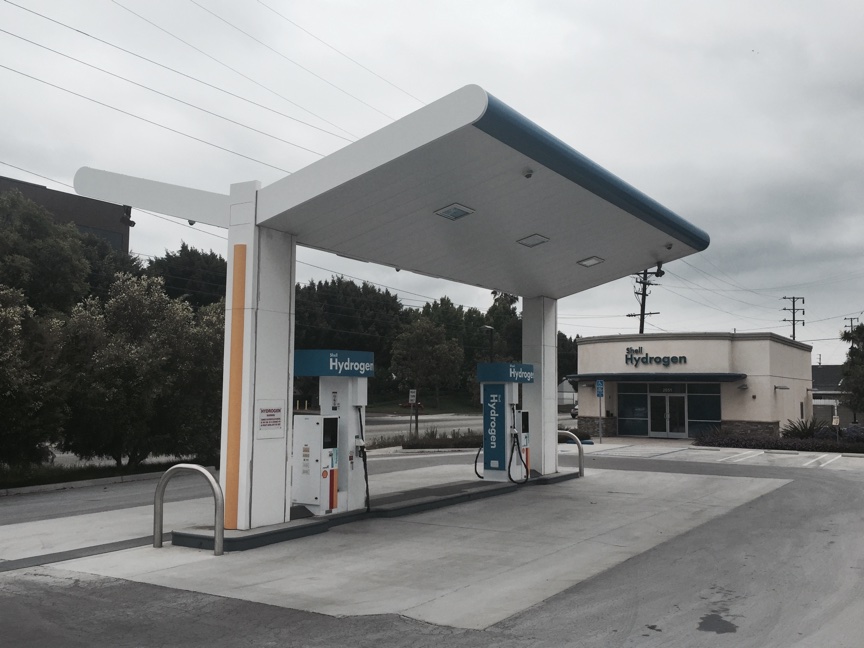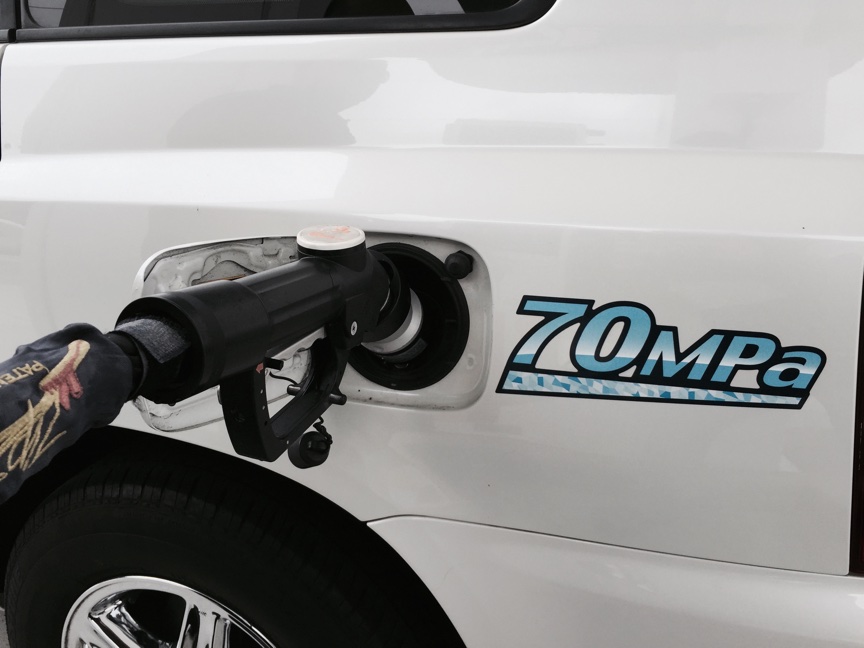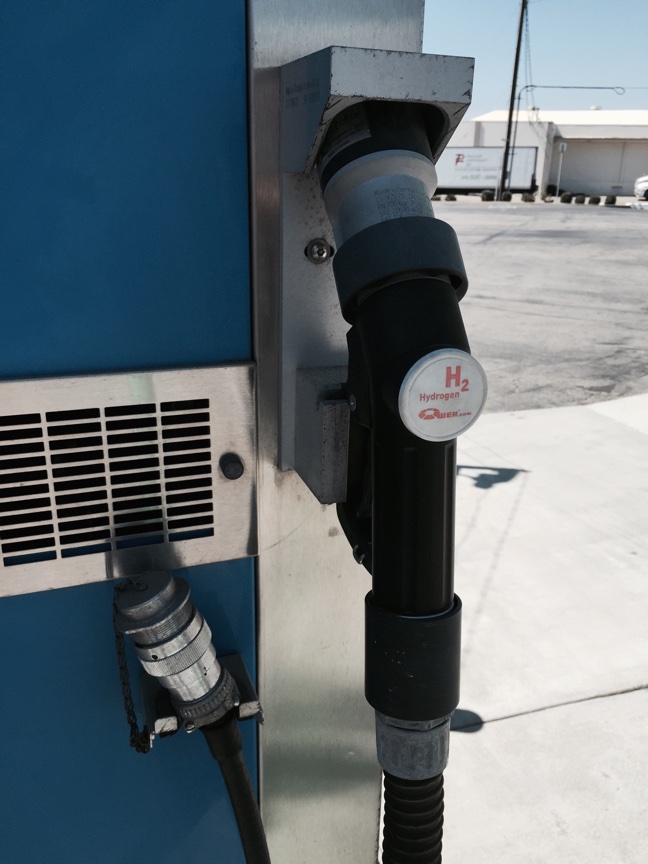
Home - AFV Events - Other AFV Events - Shell Hydrogen Station
During the nearly one and a half decades that I owned natural-gas vehicles (NGVs) while I lived in California, I became very familiar with the refueling infrastructure in that state for compressed natural gas fuel (CNG), and to a lesser extent across the country. The refueling station that I used most often, a couple of miles from my job near the Los Angeles International Airport, recently added a dispenser for hydrogen fuel, but it is kept locked up and I have never had the opportunity to see it in use. However, on a recent business trip back to California, I found out about a dedicated refueling station owned by Shell Hydrogen nearby in Torrance, and I took the opportunity to visit it on July 8, 2015.

The "compressed" part of the name "CNG" refers to the fact that natural gas is a vapor at normal temperatures and pressures, like propane (LPG), but unlike propane it does not liquefy when subjected to moderate pressure, about 300 PSI (pounds per square inch, about 20 times atmospheric pressure). Thus, in order to store enough aboard a vehicle to drive for a reasonable distance, natural gas must be compressed to very high pressures (or subjected to extremely low temperatures, at which point it does become a liquid: liquefied natural gas, or LNG). Modern CNG tanks for vehicles are designed for 3600 PSI, and my old 1993 Dodge van had 3000 PSI tanks (to this day my former primary CNG station maintains one dispenser for older vehicles that need that lower pressure). Hydrogen fuel has the same behavior as natural gas, but more so: vehicle tanks are designed for 5000 PSI or even 10,000 PSI to store enough fuel! This refueling station offers two dispensers at each pressure, with the higher pressure on the near side of each "pump" in the photo.
There was nobody on site of whom I could ask questions; the small building across the lot in the photo at top appeared to be a conference room, but it was unoccupied. Thus I don't have a lot of detail to offer about the source of the hydrogen; there were signs referring to Air Products and to the "hydrogen supply level," so I presume that Air Products brings the fuel in portable tanks, then replaces them as they are depleted. This is in contrast to a CNG station, where the fuel is usually drawn directly from underground pipelines to be compressed for use, no tanker trucks needed.

The station is right across 190th Street from Toyota's headquarters, which is no coincidence. While I was there a Toyota FCHV-adv fuel-cell vehicle (FCV), like the one I had seen a few months earlier at the Hawaii Auto Show (might even have been the same one -- I didn't check license plates), pulled in to refuel at the high-pressure side (the decal advertises this: "MPa" stands for megapascal, a metric unit of pressure, and 70 MPa is 10,000 PSI), so I did get to see the station in use. The driver (whose name I didn't catch) remarked on a phenomenon I sometimes encountered while filling up on CNG, namely that the nozzle can frost up if you put fuel into nearly-empty vehicle tanks, since the temperature of the gaseous fuel drops as it expands into the lower pressure in the tanks. The reverse is true as well, in that the temperature of a gas goes up when it is compressed; there was a little water dripping down the hose to the nozzle, and he told me that the fuel lines are water cooled to dissipate the heat from the ferocious compression to 10,000 PSI, or about 700 times atmospheric pressure!

I couldn't see what was under the fabric sheath around the hose(s); I conjecture that there probably was a second line to vent the small amount of fuel trapped in the nozzle when it is disconnected when fueling is complete (you can see such a secondary line in the photo of the CNG nozzle on the front page of this website). One thing I didn't see is a separate grounding strap, like the one to the left of the nozzle in this photo I subsequently took at the LAX refueling station. The nozzles themselves look just about identical at the two stations (actually, the 5000 PSI nozzles at the Torrance station looked more like a CNG nozzle, with a lever on top rather than a handle on the bottom -- I should've taken a photo); however, in early hydrogen refueling procedures, it was required to hook up an electrically conductive grounding strap between the vehicle and the nozzle to prevent the buildup of static electricity. Hydrogen is much more prone to ignition when mixed with air than is natural gas, so a spark is a much larger danger. Apparently more recent vehicles and nozzles have grounding provisions built in, or maybe experiments showed that flammable mixtures of hydrogen and air did not form in appreciable amounts around the nozzle during fueling. I'll have to ask somebody about that when I get the chance.
The dispensers at this station had the fuel priced at $4.99 per kilogram for 5000 PSI and $5.99 per kilogram for 10,000 PSI, but the driver of the FCHV-adv vehicle said that was just a "dummy" value, as accounting is done separately for the company vehicles that refuel there. The expectation is that, when available to the public, hydrogen will cost about $10 per kilogram. As I remarked in discussing the Toyota Mirai FCV that will soon go on sale to the public, a kilogram of hydrogen contains about as much energy as a gallon of gasoline, but an FCV uses it more efficiently than a typical gasoline vehicle, so that the Mirai gets about 60 miles per kilogram. However, that works out to six miles per dollar, which is what you'd spend for, say, $3.50 per gallon gasoline in a car that gets 21 MPG; not very attractive compared to, say, a Prius hybrid. To get over this hurdle, Toyota plans to offer free fuel for the duration of a three-year Mirai lease (I'm not sure what the provisions are for vehicles that are sold outright rather than leased). I do not know if prices are expected to come down dramatically in three years, but if not, it is difficult to see how automakers expect to grow the market for FCVs beyond early adopters (like, say, me if I still lived in California...), especially since the buildout of refueling stations beyond the present handful will take many years. And yet Toyota, in particular, has shut down production of their new RAV4-EV battery-electric vehicle (a successor to the original of a dozen years ago), saying that the zero-emissions torch is now ready to be passed to FCVs like the Mirai. Let's just say that I will be watching developments with keen interest.
 Back
to AFV Events Page
Back
to AFV Events Page Back
to Fueling Station
Back
to Fueling Station Site
Map
Site
Map Contact
Me
Contact
Me All content copyright 1998-2024 by Mark Looper, except as noted. Reuse of my copyrighted material is authorized under Creative Commons Attribution 4.0 International license (CC BY 4.0).
![]()
![]()
new 15 July 2015